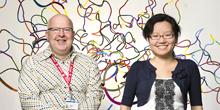
View the Image
In the world of nanotechnology, the objects being observed, manipulated and even built are often too small to absorb light and, thus, are too small to reflect colour.
The accompanying irony and host of challenges for a fine arts professor of painting being sent in to explore this literal black-and-white world of the extremely small was not lost on Allen Ball, who just finished off a year-long posting as the Scholar in Residence for Arts Research in Nanotechnology.
"A lot of a nanotechnology scientist's problems stem from the fact that they can't see what they're doing, literally," said Ball. "What a conundrum for a visual artist and a scientist alike-how do you visualize what's going on at that level?"
In applying to the residency, which was created by the Office of the Vice-President (Research) in 2010 to forge connections and dialogue between two seemingly opposite research cultures for mutual understanding and benefit, Ball proposed an idea to imagine nanotechnology in a public space.
"You can't imagine what it takes for scientists to visualize what they're doing; imagine how difficult it is for the public to engage in it," said Ball. "And the field is so vast, they cover so many different fields, there is no one image that people can connect nanotechnology with and be able to engage in it in a different way."
"NINT is connected to the university, it is connected to the community and its researchers want to share and collaborate, and show others what they're doing."
- Allen Ball
After being named artist in residence at the National Institute for Nanotechnology, Ball found himself wandering from lab to lab at NINT, talking to researchers about their work.
"It was a completely eye-opening experience for me. I had never been in science before, so it was a different way of working," he said. "I conceptualize ideas and go about creating them in the studio; I found there were similarities in the way they were realizing their problems."
The longtime fine arts alumnus admits answering the question was far more difficult to answer than he had anticipated.
"To the researcher, this incredibly complicated nanotechnology experiment is normal, but to the rest of us, we've never seen anything like it," said Ball. "The public has no grasp of how scientists are operating, but at the same time I think there are ways to visualize nanotechnology in a way that the public could be able to interact with it and become more sympathetic to it.
"In the end, I didn't just want to make this thing-that is so tiny you literally can't see it-palatable, I wanted to make it tangible and real and concrete."
Along with the interviews and numerous photographs taken, Ball, with the help of WenJaun Huang, a post-doctoral fellow in computational chemistry, completed a mural of a co-enzyme of tuberculosis, aptly named Consumption. Ball says his painting resembles a giant scribble, but is in fact what this material looks like at scale.
"Most imagery in science is in the form of equations and tidy models, but in reality this small world is pretty chaotic," he said. "I think our image of tuberculosis is much less intimidating to start to look at than a scientific model."
Ball says he chose to illustrate this aspect of tuberculosis because of its colloquial, out-of-use name, consumption. A disease that is characterized by the wasting away of body tissues, consumption is also often held up as a failing of modern society.
"By using nanotechnology, researchers are trying to make things that are faster, cheaper and use less material-all those things that impact consumption in a way that's beneficial-in a conscious effort to get more with less," said Ball.
And although his residency officially finished Sept. 1, Ball has plans to stay with this subject matter and see where it will take him.
"NINT is connected to the university, it is connected to the community and its researchers want to share and collaborate, and show others what they're doing," said Ball. "So artists can be evangelists for them and show others the good works they are doing because it is important and it is going to have a huge impact on our quality of life in the coming years. It's just a matter of time."
The next nanotechnology "evangelist" is Janet Wesselius, an associate professor of philosophy at Augustana Campus, who will take up the residency in January with a project entitled Thinking at the Nanoscale: Imaginative Metaphors and Ontological Implications. She is interested in how metaphors both enable and constrain our thinking about the nanoscale.